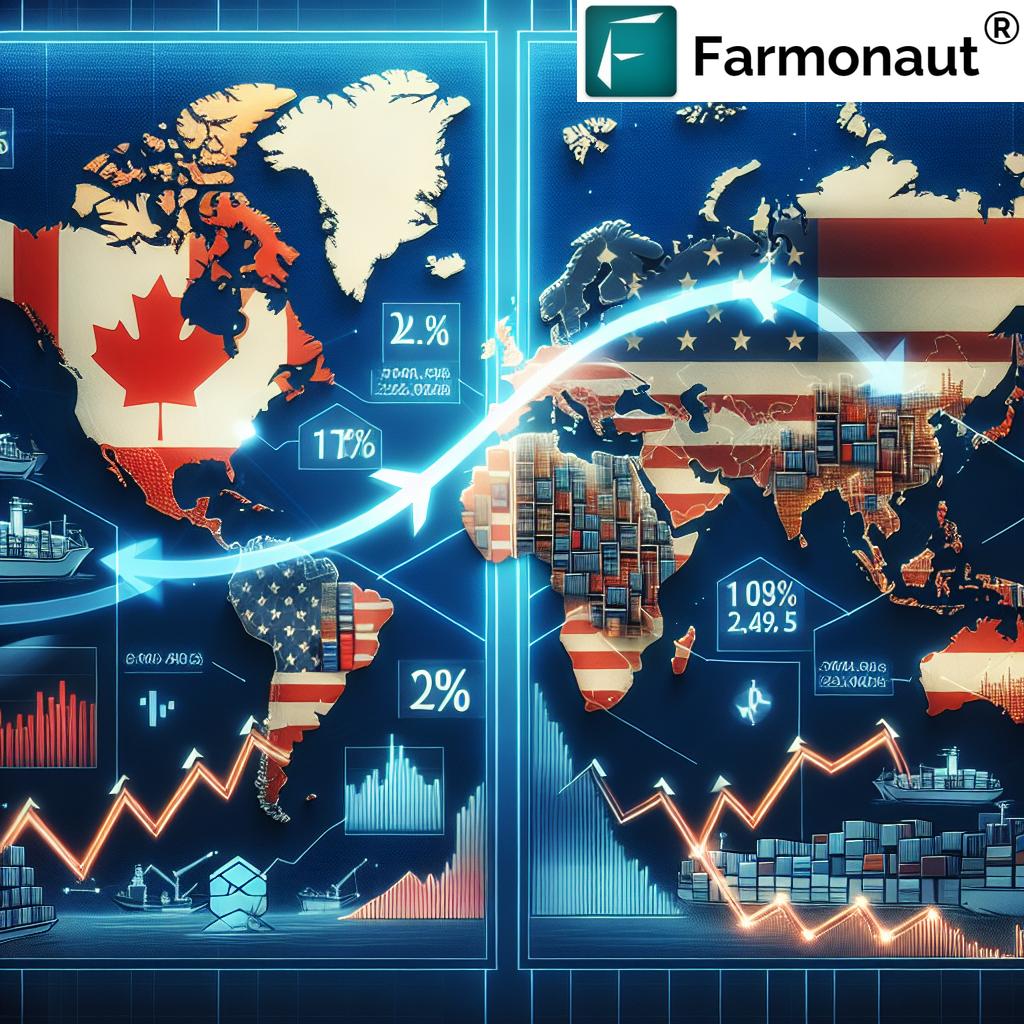Global Trade War Escalates: How Retaliatory Tariffs Impact North American Markets and Supply Chains
“Canada announced a 25% tariff on $155 billion worth of U.S. goods in retaliation to U.S. tariffs.”
In recent developments that have sent shockwaves through the global economic landscape, we find ourselves at the epicenter of an escalating trade war that threatens to reshape North American markets and disrupt international supply chains. As major economic powers engage in a tit-for-tat tariff battle, the ramifications are far-reaching, impacting businesses, consumers, and entire industries across the continent and beyond.
The Spark That Ignited the Trade War
The current trade tensions trace their roots to a decision by the United States to impose significant tariffs on imports from its North American neighbors, Canada and Mexico. This move, part of a broader strategy to protect domestic industries and address trade imbalances, has triggered a cascade of retaliatory measures that now threaten the stability of long-standing economic partnerships.
In a bold countermove, Canadian Prime Minister Justin Trudeau announced a 25% tariff on $155 billion worth of U.S. goods. This decisive action underscores the gravity of the situation and Canada’s refusal to acquiesce to economic pressure from its southern neighbor. The scope of Canada’s response is both wide-ranging and strategic, targeting a diverse array of American products from beer and wine to industrial materials like lumber and plastics.

Mexico’s Strategic Response
Meanwhile, Mexico is not standing idly by. President Claudia Sheinbaum has instructed her economic team to implement “Plan B,” a multifaceted approach combining tariff and non-tariff measures to protect Mexico’s economic interests. This strategy reflects a growing frustration with U.S. trade policies and accusations, particularly regarding drug trafficking and border security issues.
As we delve deeper into the implications of these trade policy shifts, it’s crucial to understand how they affect various sectors and the intricate web of supply chains that connect North American economies.
Sectors Under Pressure
The trade war’s impact reverberates across multiple industries:
- Energy Sector: With Canadian energy products facing a 10% tariff from the U.S., we anticipate significant disruptions in the North American energy market.
- Agricultural Industry: Farmers on both sides of the borders are bracing for impact as agricultural products become pawns in the trade dispute.
- Manufacturing: The automotive industry, deeply integrated across North America, faces particular challenges as tariffs threaten to increase production costs and disrupt supply chains.
- Consumer Goods: From household appliances to clothing, consumers are likely to see price increases as tariffs are passed down the supply chain.
“The global trade war impacts multiple sectors, potentially affecting prices of consumer goods and economic stability worldwide.”
Economic Ramifications and Market Uncertainty
Analysts predict significant consequences stemming from this trade conflict. The immediate effects include potential price hikes for consumer goods and a looming threat of economic instability. As the U.S., Canada, and Mexico are each other’s largest trading partners, the tariffs could destabilize North American trade relations, leading to rising costs for essential goods and services.
Global markets are watching closely, with uncertainty becoming the new norm. Investors and businesses alike are reassessing their strategies in light of the changing economic landscape. The ripple effects of this trade war extend far beyond North America, impacting global supply chains and potentially reshaping international trade patterns.
The China Factor
While the immediate focus is on North American trade relations, we cannot overlook the broader context of U.S.-China trade tensions. The imposition of a 10% tariff on Chinese goods by the U.S. adds another layer of complexity to the global trade picture. China’s response remains uncertain, with Beijing emphasizing its desire for collaboration on issues like counter-narcotics while navigating the economic challenges posed by U.S. tariffs.
Impact on Supply Chains and Business Operations
The escalating trade war poses significant challenges for supply chain management across North America. Businesses are now forced to reevaluate their sourcing strategies, potentially leading to:
- Diversification of suppliers to mitigate risk
- Increased inventory stockpiling to buffer against tariff uncertainties
- Exploration of alternative manufacturing locations
- Investment in technology to enhance supply chain visibility and agility
These adaptations come at a cost, potentially impacting profit margins and consumer prices. Moreover, the uncertainty surrounding trade policies makes long-term planning increasingly difficult for businesses of all sizes.
Agricultural Sector: A Case Study in Trade War Impact
The agricultural sector serves as a prime example of the trade war’s far-reaching effects. Farmers across North America are caught in the crossfire, facing challenges such as:
- Reduced export opportunities due to retaliatory tariffs
- Increased costs for farm equipment and inputs
- Market uncertainty affecting investment decisions
- Potential oversupply in domestic markets leading to price pressures
In this context, technologies that enhance agricultural efficiency and market insights become increasingly valuable. Platforms like Farmonaut offer farmers tools to optimize their operations in the face of market volatility. Through satellite-based crop monitoring and AI-driven insights, farmers can make more informed decisions about resource allocation and crop management, potentially mitigating some of the trade war’s negative impacts.

Consumer Impact: The Ripple Effect
As businesses grapple with increased costs and supply chain disruptions, consumers are likely to feel the pinch in their wallets. We anticipate:
- Higher prices for a wide range of goods, from electronics to food products
- Potential shortages of certain imported items
- Shifts in consumer behavior as people adapt to new economic realities
The full extent of these impacts may take time to materialize, but the effects are already being felt in certain sectors. Consumers may need to become more savvy in their purchasing decisions, potentially seeking alternatives or adjusting their spending habits.
Diplomatic Tensions and International Relations
Beyond the economic sphere, the trade war is straining diplomatic relations between the United States and its North American partners. Key issues include:
- Erosion of trust in international agreements and institutions
- Challenges to cooperative efforts on shared concerns like border security and drug trafficking
- Potential spillover effects on other areas of collaboration, such as defense and environmental policy
The situation underscores the delicate balance between economic interests and broader geopolitical considerations. As nations navigate these turbulent waters, the need for diplomatic finesse and strategic negotiation becomes ever more critical.
The Role of Technology in Mitigating Trade War Impacts
In the face of economic uncertainty, businesses and governments are turning to technology to gain a competitive edge and mitigate risks. Innovations in areas such as:
- Artificial Intelligence for market analysis and forecasting
- Blockchain for supply chain transparency and traceability
- Big Data analytics for consumer behavior insights
- Precision agriculture technologies for optimizing farm outputs
These technologies offer powerful tools for navigating the complexities of a shifting trade landscape. For instance, Farmonaut’s satellite-based farm management solutions provide farmers with real-time insights into crop health and market conditions, enabling more informed decision-making in uncertain times.
| Country | Tariff Imposed | Affected Sectors | Estimated Economic Impact ($B) | Potential Long-term Consequences |
|---|---|---|---|---|
| United States | 25% on Canadian and Mexican imports; 10% on Chinese goods | Steel, aluminum, automotive, agriculture | 50-100 | Increased consumer prices, potential job losses in export-dependent industries |
| Canada | 25% on $155 billion of U.S. goods | Consumer goods, industrial materials, food and beverages | 30-50 | Supply chain disruptions, potential economic slowdown |
| Mexico | “Plan B” strategy (details pending) | Agriculture, manufacturing, energy | 20-40 | Reduced foreign investment, market instability |
Looking Ahead: Scenarios and Strategies
As we look to the future, several possible scenarios emerge:
- Escalation: Further tariff increases and expansion to other sectors, potentially leading to a full-blown trade war.
- Negotiation: Diplomatic efforts lead to a de-escalation and renegotiation of trade terms.
- Status Quo: Current tariffs remain in place, creating a “new normal” for North American trade.
- Resolution: A comprehensive agreement is reached, resolving key issues and removing tariffs.
Regardless of the outcome, businesses and policymakers must prepare for a range of possibilities. Strategies for resilience might include:
- Diversifying supply chains and markets
- Investing in domestic production capabilities
- Enhancing technological infrastructure for improved agility
- Strengthening regional economic partnerships
The Path Forward: Collaboration and Innovation
While the current trade climate poses significant challenges, it also presents opportunities for innovation and collaboration. We see potential for:
- Development of new technologies to enhance trade efficiency and transparency
- Strengthening of regional economic ties to create more resilient markets
- Emergence of new business models adapted to the changing global trade landscape
- Increased focus on sustainable and localized production methods
In this context, solutions like those offered by Farmonaut become increasingly relevant. By providing tools for precision agriculture and market insights, such platforms empower businesses to adapt and thrive in uncertain times.
Conclusion: Navigating Uncertain Waters
The escalating trade war between the United States, Canada, and Mexico marks a significant shift in North American economic relations. As retaliatory tariffs reshape markets and disrupt supply chains, businesses, consumers, and policymakers must navigate an increasingly complex and uncertain landscape.
While the challenges are significant, they also present opportunities for innovation, adaptation, and the forging of new economic partnerships. By leveraging technology, diversifying strategies, and fostering collaboration, stakeholders across North America can work to mitigate the negative impacts of trade tensions and build more resilient economic frameworks for the future.
As we continue to monitor these developments, one thing remains clear: the global trade landscape is undergoing a profound transformation. How nations and businesses respond to these changes will shape the economic realities of North America and beyond for years to come.
FAQ Section
Q: What triggered the current trade war?
A: The trade war was triggered by the United States’ decision to impose significant tariffs on imports from Canada and Mexico, as well as a 10% tariff on goods from China.
Q: How has Canada responded to U.S. tariffs?
A: Canada has announced a retaliatory 25% tariff on $155 billion worth of U.S. goods, targeting a wide range of products including beer, wine, lumber, and plastics.
Q: What is Mexico’s response to the trade tensions?
A: Mexico is implementing a strategy called “Plan B,” which includes a combination of tariff and non-tariff measures to protect its economic interests.
Q: How might consumers be affected by these trade tensions?
A: Consumers are likely to see increased prices for a wide range of goods, from food products to electronics, as businesses pass on the costs of tariffs.
Q: What sectors are most affected by the trade war?
A: Key affected sectors include energy, agriculture, manufacturing (particularly automotive), and consumer goods industries.
Q: How are businesses adapting to the new trade landscape?
A: Businesses are diversifying supply chains, exploring new markets, investing in technology for better supply chain visibility, and in some cases, relocating production to avoid tariffs.
Q: What role does technology play in mitigating the impacts of the trade war?
A: Technologies like AI, blockchain, and data analytics are being used to enhance supply chain efficiency, provide market insights, and improve decision-making in uncertain conditions.
Q: How might the trade war affect global markets beyond North America?
A: The trade war could lead to shifts in global supply chains, affect international commodity prices, and potentially slow global economic growth due to reduced trade and increased uncertainty.
Earn With Farmonaut
Earn 20% recurring commission with Farmonaut’s affiliate program by sharing your promo code and helping farmers save 10%. Onboard 10 Elite farmers monthly to earn a minimum of $148,000 annually—start now and grow your income!
Learn More About Our Affiliate Program
Farmonaut Subscriptions
Download Farmonaut Apps:
For developers interested in integrating Farmonaut’s powerful satellite and weather data into their applications, check out our API and API Developer Docs.







